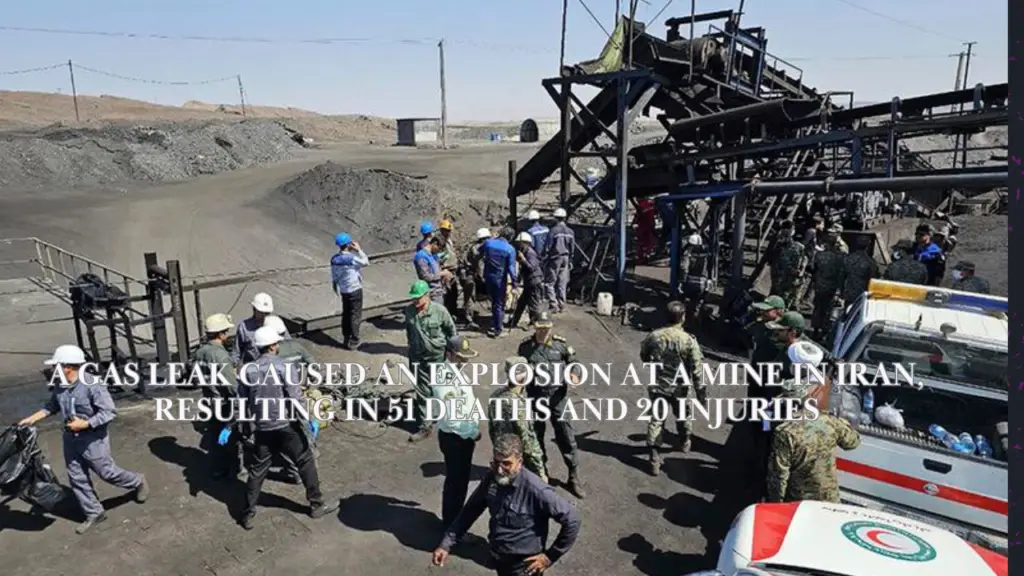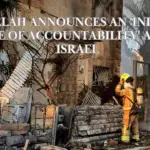A devastating explosion caused by a gas leak at a coal mine in Iran’s eastern region resulted in the deaths of at least 51 people, making it one of the most tragic workplace accidents the country has seen in recent years. The incident occurred at the Tabas mine, which is located in South Khorasan province, and has brought attention to the dangers faced by miners, as well as the urgent need for safety measures in such hazardous working environments.
According to reports from Iran’s state media, the explosion took place at around 9:00 p.m. (2300 IST) on Saturday, when approximately 70 workers were present at the mine. Initial reports indicated that 30 people had lost their lives, but the death toll quickly rose to 51 as rescue operations continued and more bodies were discovered. The blast also left 20 other miners injured, with many of them suffering from severe injuries due to the explosion and exposure to dangerous gases.
The cause of the explosion was attributed to a methane gas leak, which had accumulated in two sections of the mine. Methane is a common hazard in coal mining operations, and if not properly ventilated, it can lead to highly flammable and explosive conditions. In this case, the gas leak caused a massive explosion, destroying parts of the mine and trapping many workers underground. The mine, owned by a private Iranian company called Madanjoo, had chambers filled with concentrated methane gas, which made rescue operations extremely challenging and dangerous for emergency teams.
In the immediate aftermath of the explosion, Iran’s Red Crescent organization launched search and rescue operations to try and save the trapped workers. However, the rescuers faced significant challenges as they struggled to navigate through chambers filled with methane gas, which made it difficult to reach those trapped. The workers were approximately 250 meters below the surface, and the accumulation of gas in the mine hampered rescue efforts, as it posed the risk of further explosions and endangered the lives of the rescue teams. The local prosecutor, Ali Nesaei, acknowledged that the “gas accumulation in the mine” had made the search operations particularly difficult, complicating the efforts to save those still trapped underground.
President Masoud Pezeshkian, who was about to depart for the UN General Assembly in New York, addressed the nation, expressing his condolences to the families of the victims and promising a thorough investigation into the accident. “Unfortunately, we learned that an accident occurred in one of the coal mines in Tabas, and some of our compatriots lost their lives,” he said in his statement. He conveyed his deep sorrow and emphasized that the government would take action to understand the cause of the explosion and to prevent similar tragedies from occurring in the future.
In addition, Iran’s first Vice-President, Mohammad Reza Aref, took immediate action by speaking with Cabinet members to ensure that all necessary measures were taken to support the victims and their families. He instructed government officials to provide an “emergency follow-up” on the situation, ensuring that the affected families received assistance and that the injured workers were given the necessary medical treatment. The authorities also declared three days of public mourning in the eastern province of South Khorasan to honor those who lost their lives in the tragic accident.
The mine explosion at Tabas has raised serious questions about the safety standards and working conditions in Iran’s coal mining industry. Mining is inherently dangerous, and the risk of gas explosions is a well-known hazard. However, proper safety measures and regulations can significantly reduce these risks. In the case of the Tabas mine, the fact that such a high concentration of methane gas was allowed to build up suggests that safety protocols may not have been adequately enforced, or that proper ventilation systems were not in place. This has led to widespread criticism and calls for the government to improve safety standards to protect the lives of miners.
Iran has a history of mining accidents, and this latest tragedy has sparked discussions about the need for stricter safety regulations and better enforcement of existing rules. In recent years, there have been multiple incidents in coal mines across the country, often caused by gas leaks or inadequate safety measures. For instance, just last year, a similar explosion occurred at a coal mine in the northern city of Damghan, resulting in the deaths of six miners. The cause of that explosion was also attributed to a methane gas leak, indicating that the issue is not an isolated one, but rather a systemic problem within the industry.
The dangers of methane gas in coal mines are well-known. Methane, which is released during the mining process, is highly combustible, and if not properly ventilated, can accumulate to dangerous levels. When it reaches a certain concentration, even a small spark can cause a massive explosion, as was the case in the Tabas mine. The presence of this gas is a constant threat in coal mining operations, and strict safety protocols, including proper ventilation systems and regular monitoring of gas levels, are essential to prevent such disasters. The fact that this explosion occurred suggests that there may have been lapses in safety procedures, either due to negligence or inadequate regulation.
The Tabas mine tragedy has drawn attention to the need for improved safety training for workers as well. Miners should be equipped with the knowledge and skills to recognize the signs of gas leaks and understand how to respond in emergency situations. Additionally, mine operators must be held accountable for ensuring that safety equipment, such as gas detectors and ventilation systems, is properly maintained and in working condition at all times. This incident serves as a stark reminder of the importance of safety in the mining industry and the potentially fatal consequences of failing to adhere to safety regulations.
In response to the accident, there have been calls for the Iranian government to conduct a thorough investigation into the incident and to take action to prevent future tragedies. Many believe that stricter enforcement of safety regulations, regular inspections of mines, and improved training for workers are necessary steps to ensure that such accidents do not happen again. There is also a growing demand for more transparency regarding the conditions in Iran’s mines, as well as for holding those responsible for safety violations accountable.
The explosion at the Tabas mine has not only resulted in a tragic loss of life but has also highlighted the broader issues facing Iran’s coal mining industry. It has underscored the dangers that miners face daily and the need for urgent reforms to protect workers’ lives. While the Iranian government has expressed its condolences and pledged to investigate the incident, it remains to be seen whether concrete actions will be taken to address the underlying issues and improve safety standards in the industry.
In conclusion, the Tabas mine explosion serves as a grim reminder of the risks associated with coal mining and the importance of strict safety measures to protect workers. The incident, which claimed the lives of 51 miners and injured 20 others, has sparked a national conversation about the need for improved safety regulations, better enforcement, and greater accountability within the mining industry. As the country mourns the loss of these workers, it is crucial that this tragedy serves as a catalyst for change, leading to safer working conditions and the implementation of measures that can prevent similar accidents in the future.


